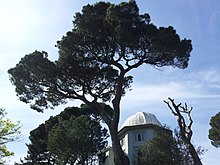Kandilli Observatory
The Kandilli Observatory or officially the Kandilli Observatory and Earthquake Research Institute ( Turkish: Kandilli Rasathanesi ve Deprem Araştırma Enstitüsü ; KRDAE for short) is a Turkish observatory and weather station that also specializes in seismology . It is located on a hill overlooking the Bosphorus in the Kandilli district of the Üsküdar district on the Anatolian side of Istanbul . The observatory is part of the Boğaziçi Üniversitesi .
history
Well-known astronomers in the Ottoman Empire were ʿAlī al-Qūschdschī († 1474) and Taqi ad-Din († 1585), who introduced the science of astronomy to the Ottoman madrasa . For a long time afterwards, however, astronomy was limited to mere timekeeping and the setting of times of prayer. With the reforms and modernization of the Ottoman administration and the military in the middle of the 19th century, astronomy was introduced as a subject in universities.
The observatory, originally called the "Grand Magnificent Observatory" ( osm . : Rasathane-i Amire), was founded in Pera on the European side of Istanbul in 1868 and was mainly dedicated to weather forecasting and precise timekeeping. The observatory was built with the help of the French and instruments were imported from Europe. The first director was Aristide Coumbary.
With the great earthquake in Istanbul in 1894 , the need for an earthquake control station became clear. Shortly afterwards, two seismographs were bought from Italy and one of them was placed in the Rasathane-i Amire - the second went to the Yıldız palace of Sultan Abdülhamid II. G. Agamemnone was invited from Rome to Istanbul for support. He set up a network of several measuring stations in the Ottoman Empire and trained the staff at the facility. But when he left Istanbul in 1897, the observations were no longer carried out so systematically.
During the unrest on March 31, 1909 , the observatory was destroyed by rebels - remains were housed in Maçka (Beşiktaş district). The next year, however, Professor Fatin (later Fatin Gökmen) was tasked with restoring the observatory. He selected the current location on İcadiye Hill. Systematic research began on July 1, 1911. After several name changes, the name "Kandilli Observatory, Astronomy and Geophysics" was used in 1940. In 1982 the observatory was affiliated with the Boğaziçi Üniversitesi. The institution was later renamed Kandilli Rasathanesi ve Deprem Araştırma Enstitüsü.
Directors
- Aristide Coumbary
- Salih Zeki Bey
- Bedii Bey
- Fatin Gokmen
organization
The Kandilli Observatory consists of the following departments, laboratories and other facilities:
Departments:
- Earthquake-proof construction
- geodesy
- geophysics
Laboratories:
- astronomy
- Geomagnetism
- meteorology
- optics
Other facilities:
- Earthquake museum
- National Earthquake Monitoring Center
- Magnetic monitoring station
- Geodesy and magnetic monitoring station
- Disaster Risk Reduction Department
- Sun tower
- Institute for Biomedical Technology
- Research center for telecommunications and information technology
In addition, the observatory operates the following centers outside the campus:
- Belbaşı Nuclear Tests Monitoring Center, formerly Belbaşı Seismic Research Station (Belbaşı, Ankara Province)
- Iznik Earthquake Reduction Center (Iznik Deprem Zararlarinin Azaltilmasi Merkezi) (Iznik, Bursa Province)
Web links
Coordinates: 41 ° 3 ′ 48 ″ N , 29 ° 3 ′ 44 ″ E
